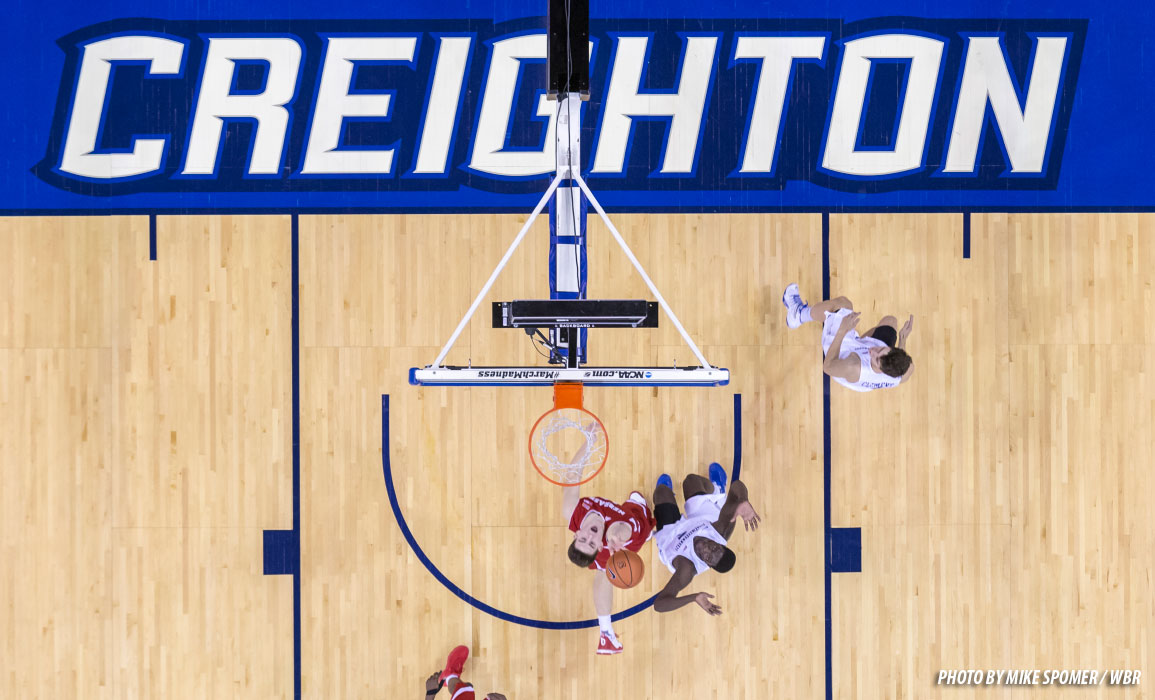The non-conference slate is complete, and the Jays finished with a 9-4 mark. It’s been an interesting start to the season, and as the Jays prepare for Big East play to begin on New Years Eve, we thought we’d take a look back at the highs and lows of the first 13 games.
The Offense:
Over the first 13 games of the season, Creighton’s offense has often been prolific. Their effective field goal percentage is 58.1%, seventh-best in Division 1. Their three-point field goal percentage is 40.1%, 24th-best in D1. Even better, their two-point field goal percentage is 56.8%, 15th-best in D1. And they’ve assisted on 57.6% of their made baskets, 75th-best. As a result, they’ve scored 100 or more points in three separate games, the first time they’ve done that since 1989-90 and just the fourth time in school history they’ve done it that many times in a season. And they’ve got at least 19 more games to go! Prior to this week, when they scored 100+ in back-to-back games, they hadn’t scored 100+ twice in the same MONTH since February of 1990.
The Bluejays have scored 90+ in eight of their 13 games, after doing so 21 times in Greg McDermott’s first five years at Creighton combined — that’s right, the 2015-16 Bluejays are scoring more points than any of his previous teams at CU, even the ones led by Doug McDermott and Co. Actually, that’s not entirely true; they’re scoring more than any of Mac’s teams in D1 have. At Northern Iowa and Iowa State, his squads scored 90+ a grand total of six times in 280 games, and they’ve topped that already in just 13 tries this season!
And it’s not just the teams of the Greg McDermott Era they’re outscoring; this group of Bluejays is averaging 87.4 points per game, the highest mark through 13 games in school history. The single-season record is 88.2 points per game, set in 1965-66, but even that squad wasn’t THIS good THIS early; they averaged just 85.5 points through the first 13 games.
They’ve scored 165 fast-break points in the first 13 games (12.6 per game), after scoring a grand total of 143 last year in 35 games (4.3 per game). Their adjusted tempo of 72.8 possessions per game ranks 56th in the country, nearly three possessions more than the average D1 team and exactly ten possessions more than last year’s team. This is BY FAR the fastest pace the Jays have played in the Greg McDermott Era, the first time they’ve played at a faster tempo than the D1 average since 2011, and the fastest Bluejay team period in over a decade:
| Season | Adj. Tempo | D1 Avg. | Rank |
|---|---|---|---|
| 2015-16 | 72.8 | 70.0 | 55 |
| 2014-15 | 62.8 | 64.8 | 275 |
| 2013-14 | 64.9 | 66.4 | 252 |
| 2012-13 | 64.8 | 65.9 | 221 |
| 2011-12 | 66.6 | 66.1 | 140 |
| 2010-11 | 64.9 | 66.7 | 255 |
| 2009-10 | 66.5 | 67.3 | 207 |
| 2008-09 | 68.4 | 66.5 | 84 |
| 2007-08 | 67.0 | 67.0 | 159 |
| 2006-07 | 63.6 | 66.9 | 290 |
| 2005-06 | 63.9 | 67.0 | 278 |
| 2004-05 | 64.4 | 67.3 | 275 |
| 2003-04 | 65.5 | 67.7 | 243 |
| 2002-03 | 70.1 | 68.5 | 92 |
A by-product of that faster pace is more dunks, evidenced by 32 slams in the first 13 games after 29 all of last year. And overall, it’s led to a higher percentage of shots taken in the paint (and thus, a fewer percentage of shots taken from three-point range):
| Season | Pct. of Total Points | 3PA / FGA | 3PT FG% |
|---|---|---|---|
| 2015-16 | 32.0% | 37.4% | 40.1% |
| 2014-15 | 35.4% | 42.7% | 34.6% |
| 2013-14 | 38.8% | 44.5% | 41.5% |
| 2012-13 | 34.4% | 39.4% | 41.4% |
| 2011-12 | 31.1% | 35.0% | 42.4% |
| 2010-11 | 31.3% | 37.3% | 36.9% |
In other words, 37.4% of their shots this year have been three-pointers, the lowest percentage since 2011-12 when 35.0% of their shots were from long range. And 32% of their points have come via the three-pointer, also the lowest since 2011-12 when 31.1% of their points were on three-pointers. Interestingly, while they’ve attempted a lot fewer three-pointers this year, they’re making the ones they do shoot at a much higher clip. They’ve made 121 three-pointers, trailing only the 2013-14 team for most through 13 games; that historic squad had 149 at the same point.
Their overall shooting percentage is 50.6%, the third-best mark through 13 games in the last 20 years. The only two teams that were better? The 2002-03 team led by Kyle Korver (51.0%) and the 2012-13 team led by Doug McDermott (50.8%).
The offensive production has been spread out, as well. They have four players averaging in double-figures and a fifth just a couple of tenths away from joining them:
- Maurice Watson (12.5 ppg)
- Geoff Groselle (12.2 ppg)
- Cole Huff (11.5 ppg)
- Isaiah Zierden (11.4 ppg)
- Khyri Thomas (9.8 ppg)
That makes them the first Creighton squad with three or more players in double-figures after 13 games since 1994-95. They’ve had 11 different players score in double-figures in at least one game, and against Coppin State, they had all five starters in double-figures in the same game for the first time since 2010, and seven total players score in double-figures for the first time since 1980-81.
Individually, Maurice Watson, Jr. has scored the most points by a Bluejay newcomer in their first 13 games (over the past 20 years) with 162 points. Cole Huff isn’t far behind with 149, good for third place on that list. Second? Some guy named Doug McDermott, who had 157.
Khyri Thomas has scored 128 over that span, making him the first freshman to score that many in their first 13 games since P’Allen Stinnett. Notably, the only Creighton freshman to score more than Thomas in the first 13 games of their careers? Doug McDermott, Rodney Buford, Ryan Sears, and Stinnett. Thomas also scored 22 points in the road loss at Loyola, giving him the most points for a Bluejay freshman in a true road game since Buford’s 22 points at Wichita State in February of 1996.
Geoff Groselle is 16-17 from the field in his last two games, moving him to a remarkable 73.3% from the field for the year. That’s tops in the Big East, and second nationally among players who’ve played in 75% of their team’s games and had five or more FG attempts a game — only Tyler Davis of Texas A&M (78.8%) is better.
Now, obviously these numbers will go down somewhat in conference play; the competition and the opposing defenses will get exponentially better. They’ll need their offensive production to not completely drop off a cliff, though, because they’re not going to win games with their defense.
The Defense:
Oh, the Bluejays defense. Where to start? Much maligned, through 13 games the Jays have been branded with a reputation for having a horrible defense, and while that’s not entirely true, I was curious just how good (or bad) they really are.
They’ve allowed opponents to make 36.3% of their three-point attempts, 249th-worst in D1. The interior defense has been a little better, owing to their defensive strategy of packing the paint to cut down on dribble penetration, as they’ve allowed opponents to shoot 47.7% on two-pointers, 147th in D1 (ranking them in the top half! Hooray!). Overall, their defensive efficiency according to KenPom is 101.7, ranking 164th. That means they give up 101.7 points per 100 possessions, putting them about a half-point better than the average defense.
Here’s a breakdown, game-by-game, of how their defense has performed versus that opponent’s season averages:
| Opponent | Pts. Scored | Pts. Per Game | 2FG% | 2FG% Avg. | 3FG% | 3FG% Avg. | Poss./Avg. |
|---|---|---|---|---|---|---|---|
| Texas So. | 70 | 68.8 | 19-35 (54.2%) | 18-37 (49.6%) | 7-17 (41.2%) | 7-21 (33.3%) | 74 / 69 |
| UTSA | 78 | 71.2 | 16-35 (45.7%) | 18-37 (48.6%) | 10-23 (43.5%) | 7-22 (31.8%) | 82 / 75 |
| @ Indiana | 86 | 89.1 | 25-42 (59.5%) | 21-36 (58.3%) | 10-28 (35.7%) | 10-23 (43.4%) | 77 / 72 |
| Rutgers | 75 | 69.8 | 23-51 (45.0%) | 20-44 (45.4%) | 6-16 (37.5%) | 5-15 (33.3%) | 78 / 71 |
| UMass | 76 | 79.6 | 20-43 (46.5%) | 20-39 (51.2%) | 3-16 (18.7%) | 8-22 (36.3%) | 79 / 73 |
| Western Ill. | 67 | 74.3 | 17-38 (44.7%) | 18-39 (46.1%) | 10-22 (45.4%) | 8-19 (42.1%) | 66 / 69 |
| Arizona St. | 79 | 75.5 | 24-43 (55.8%) | 19-38 (50.0%) | 7-17 (41.2%) | 7-22 (31.8%) | 68 / 69 |
| @ Loyola Chi. | 68 | 65.7 | 17-40 (42.5%) | 16-36 (44.4%) | 8-20 (40.0%) | 7-18 (38.8%) | 65 / 66 |
| Nebraska | 67 | 73.7 | 23-47 (48.9%) | 18-38 (47.3%) | 4-21 (19.0%) | 6-17 (35.2%) | 78 / 70 |
| IUPUI | 65 | 66.7 | 16-42 (38.0%) | 17-40 (42.5%) | 5-23 (21.7%) | 6-19 (31.5%) | 70 / 71 |
| @ Oklahoma | 87 | 87.0 | 23-45 (51.1%) | 20-40 (50.0%) | 8-20 (40.0%) | 10-22 (45.4%) | 76 / 73 |
| North Texas | 82 | 77.9 | 22-46 (47.8%) | 21-38 (55.2%) | 5-14 (35.7%) | 6-18 (33.3%) | 79 / 71 |
| Coppin St. | 77 | 70.8 | 13-34 (38.2%) | 17-42 (40.4%) | 12-25 (48.0%) | 6-21 (28.5%) | 71 / 73 |
The data bears out the KenPom defensive efficiency ranking — Creighton is an average-to-slightly-above-average defensive team. They’ve held six of 13 opponents at or below their points per game average. They’ve held five of 13 opponents to at or below their two-point field goal average, in terms of made baskets. So roughly half, or, you know, average.
Shockingly, they’ve held nine of 13 opponents to at or below their three-point average, in terms of made baskets. That’s solidly above average, and I never would have guessed that in a million years. In those nine games, the opponent has attempted fewer three-pointers than their average per-game attempt five times, hence the high season shooting percentage.
One other note on the defense: the last column in the above table is the possessions in the game versus Creighton compared to that opponent’s average number of possessions in a game. In eight of 13 games, the game vs CU has had more possessions than usual, sometimes significantly so, and with more possessions there’s going to be more shot attempts (and more made field goals).
Pace of play will be something to keep an eye on as Big East action gets underway. The Bluejays would love to continue playing games with 70-75 possessions, but to do that they need their defense to get stops and their defenders to rebound missed shots so they can run in transition. If that possession number creeps back into the mid-60s consistently, where it was a year ago, that bodes poorly for Creighton’s chances to finish better than a year ago.
The Schedule:
Before the season, Creighton’s non-conference slate was generally considered good, not great, with a nice balance of top-tier teams, mid-range teams, and cupcakes. The opponents have not been as good as they were predicted to be, and at the conclusion of non-conference play, the Jays NCSOS is ranked as the 292nd toughest according to KenPom — meaning only 59 teams played a worse slate of games.
Among the 13 contests, just three came against Top 100 teams as ranked by KenPom (#1 Oklahoma, #21 Indiana, #51 Arizona State). The Jays lost all three. Four more came against teams 100-199 (#136 Nebraska, #155 UMass, #192 Loyola Chicago, #195 Western Illinois) and the Jays went 3-1 against them. The remaining six games were against teams ranked 245 or lower (out of 351), and thankfully the Jays went 6-0 in those.
Creighton isn’t expected to be in the conversation for an NCAA Tournament berth come March, so this isn’t as much of a factor as it would be in other years. But if they do enough damage in the Big East to play themselves onto the bubble, this is a schedule — and a resume against it — that will do them no favors.
Oh, how different things might be if they’d not blown an eight-point lead to Arizona State, and if they’d played well enough at Loyola to get the win. An 11-2 team with a win over a borderline Top 50 team and no bad losses? That’s not a great resume, but not bad either. Teams from power conferences with nine or 10 league wins and 20 or 21 overall wins have gotten NCAA bids with resumes like that.
Alas.
Outlook:
At 9-4, the Jays have some work to do to even get an NIT bid. There’s four elite teams in the Big East — Xavier, Villanova, Butler, and Providence. Stranger things have happened, but odds are the Jays lose on the road to all four. It’s probable they upset one of the four at home, with an outside chance of knocking off two of them. If the latter happens, it puts them at 2-6 in the league, and 11-10 overall.
The middle of the conference seems to be Creighton, Seton Hall, Marquette, and Georgetown in no particular order. Best guess? The Jays go 3-0 at home against them, and 1-2 on the road. That moves them to 6-8 in the league, and 15-13 overall.
The bottom of the league is clearly St. John’s and DePaul at this point, although both have proven to be feisty at times in the non-conference and will not be easy to beat. While it’s tempting to think the Jays could sweep those four games, they probably lose one. A 3-1 mark against them moves CU to 9-9 in the league, 18-13 overall before the Big East tourney, and likely into an NIT berth as a mid-bracket seed.
Should they steal one or two somewhere to get near 20 wins, their non-conference resume (or lack thereof) becomes a factor. The guess here is they need at least 12 Big East wins to overcome their non-conference performance and become a serious contender for an at-large spot, and even then there probably isn’t the body of work outside the league to get over the hump, even in a league as good as the Big East. And with 12 wins seeming next-to-impossible to find, the best guess is the Jays end up in the NIT, which would be a nice landing spot for a program on the rebound.
Then again, you never know, and that’s why they play the games. We’ll start to learn the answers to these questions Thursday afternoon in NYC, as Creighton’s third Big East season tips off.


